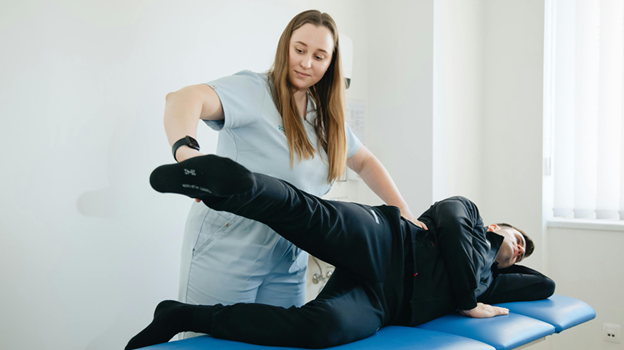
Hospital readmissions place a heavy burden on patients, families, and the healthcare system as a whole. For individuals, returning to the hospital often means setbacks in recovery, added stress, and new financial challenges. For hospitals and insurers, high readmission rates can result in penalties and unnecessary costs. Fortunately, rehabilitation has proven to be one of the most effective strategies for breaking this cycle. By equipping patients with the right tools, therapies, and guidance, rehab programs reduce the likelihood of preventable complications and help patients maintain long-term health.
Below, we explore some of the most impactful rehabilitation tools and therapies that are not only improving patient outcomes but also saving significant costs across the healthcare system.
1. Physical Therapy for Mobility and Strength
Physical therapy is at the heart of many rehab programs. After a hospital stay—especially following surgery or serious illness—patients often face reduced mobility and muscle weakness. These physical challenges increase the risk of falls, secondary injuries, and complications that can lead to readmission.
Structured physical therapy sessions build strength, improve flexibility, and restore balance. More importantly, physical therapists teach patients targeted exercises they can continue at home. This continuity of care helps prevent setbacks and supports independence, which directly lowers the likelihood of unnecessary hospital returns.
2. Occupational Therapy for Daily Living Skills
Beyond mobility, many patients struggle with the basic activities of daily life once discharged. Occupational therapy addresses these challenges by focusing on practical skills such as bathing, dressing, cooking, and safe movement around the home.
By teaching adaptive strategies and recommending assistive devices, occupational therapists empower patients to regain confidence and self-sufficiency. This support reduces dependence on caregivers, lowers the risk of accidents, and helps patients maintain stability in their recovery journey—critical steps in preventing readmissions.
3. Cardiac and Pulmonary Rehabilitation
Chronic conditions like heart disease and chronic obstructive pulmonary disease (COPD) are leading drivers of hospital readmissions. Cardiac and pulmonary rehabilitation programs are designed to interrupt this cycle.
Through a mix of monitored exercise, education, and lifestyle modification coaching, these specialized rehab services help patients better manage their conditions. Patients learn how to recognize warning signs, control symptoms, and make healthier choices. As a result, readmission rates for cardiac and pulmonary patients drop significantly, with cost savings that ripple across the healthcare system.
4. Acupuncture and Pain Management Therapies
Uncontrolled pain is one of the most common reasons patients return to the hospital. Rehabilitation programs increasingly incorporate integrative therapies such as acupuncture, massage, and mindfulness-based stress reduction to address this issue.
Acupuncture, in particular, has been shown to reduce chronic pain, improve sleep, and decrease reliance on opioid medications. By managing pain effectively without heavy pharmacological intervention, these therapies reduce complications and improve quality of life. Patients who can control their pain at home are less likely to need emergency care or hospital readmission.
5. Nutrition Counseling for Healing and Prevention
Proper nutrition plays a vital role in recovery, yet it is often overlooked in discharge planning. Malnutrition, poor dietary habits, and unmanaged weight issues can all contribute to worsening conditions and hospital returns.
Rehabilitation programs that include nutrition counseling help patients adopt healthier eating habits tailored to their specific conditions. Whether it’s managing diabetes, supporting heart health, or rebuilding strength after surgery, personalized nutrition plans accelerate healing and reduce complications. The cost savings from fewer complications and shorter recovery times are substantial.
6. Telerehabilitation and Remote Monitoring
One of the most promising developments in modern rehab is the use of telehealth and remote monitoring tools. Telerehabilitation allows patients to continue therapy from home via video sessions, smartphone apps, and connected devices. Remote monitoring tools track vital signs, exercise compliance, and other health indicators.
These technologies bridge the gap between discharge and follow-up appointments, ensuring that patients receive consistent care and early interventions when issues arise. By catching potential problems before they escalate, telerehabilitation helps reduce preventable hospital visits while improving accessibility and convenience.
7. Patient Education and Self-Management Training
Education is a cornerstone of successful rehabilitation. Patients who understand their condition, treatment plan, and warning signs are far better equipped to avoid complications. Self-management training teaches individuals how to monitor symptoms, take medications correctly, and seek timely care before emergencies occur.
This empowerment not only reduces readmissions but also fosters a stronger sense of control over health outcomes. A well-informed patient, supported by a rehabilitation therapist, becomes an active partner in their recovery rather than a passive recipient of care.
The Bottom Line: Better Care, Lower Costs
Hospital readmissions are not only disruptive to patients—they are also extremely expensive. The good news is that rehabilitation therapies provide a proactive solution. By addressing mobility, pain, nutrition, education, and ongoing support, rehab programs target the root causes of preventable readmissions.
Physical therapists, occupational therapists, nutrition counselors, and integrative care specialists all play critical roles in this effort. Together, they help patients achieve sustainable recovery and avoid unnecessary hospital stays.
The result? Patients experience greater independence and quality of life, while hospitals, insurers, and the healthcare system as a whole save significant costs. As healthcare continues to evolve, rehabilitation stands out as one of the most effective strategies for reducing readmissions and building a healthier future for all.

